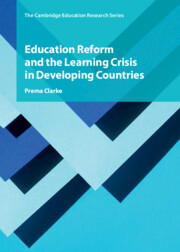Book contents
- Education Reform and the Learning Crisis in Developing Countries
- Education Reform and the Learning Crisis in Developing Countries
- Copyright page
- Contents
- Figures, Tables, and Boxes
- Acknowledgments
- Introduction
- 1 The Learning Crisis
- 2 Donor Programming in Education
- 3 Best Practice and Research in Education
- 4 Creating an Evidence Base for Learning
- Epilogue
- Index
- References
2 - Donor Programming in Education
Published online by Cambridge University Press: 08 September 2022
- Education Reform and the Learning Crisis in Developing Countries
- Education Reform and the Learning Crisis in Developing Countries
- Copyright page
- Contents
- Figures, Tables, and Boxes
- Acknowledgments
- Introduction
- 1 The Learning Crisis
- 2 Donor Programming in Education
- 3 Best Practice and Research in Education
- 4 Creating an Evidence Base for Learning
- Epilogue
- Index
- References
Summary
The second chapter moves from the learning crisis to IDFI programming in education. Based on the three main donors involved with primary education (World Bank, DFID, and USAID), it examines the process of designing projects in developing countries and the interventions that were financed. Early emphasis was on developing school infrastructure. Initial research, especially the school effectiveness studies, informed donor decisions on the content of their financing of education reform. There is an evolution in IDFI approach with a singular focus on developing infrastructure to a collective construction of a basket of investments for quality education based on best practice. There are commonalities across agencies in the interventions that are financed. Each of the areas contained in this basket are discussed in detail in light of the learning crisis – instructional materials, teacher training, and community mobilization. The chapter concludes by identifying the gaps in programming that have led to the learning crisis. In the final evaluation, the interorganizational reflection and systems learning that would have helped to comprehend and attend to the learning crisis did not happen.
Keywords
- Type
- Chapter
- Information
- Publisher: Cambridge University PressPrint publication year: 2022



